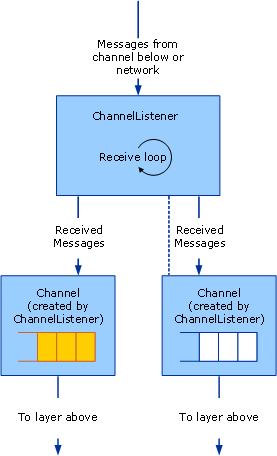Service: Channel listeners and channels
There are three categories of channel objects: channels, channel listeners, and channel factories. Channels are the interface between the application and the channel stack. Channel listeners are responsible for creating channels on the receive (or listen) side, typically in response to a new incoming message or connection. Channel factories are responsible for creating channels on the send side to initiate communication with an endpoint.
Channel listeners and channels
Channel listeners are responsible for creating channels and receiving messages from the layer below or from the network. Received messages are delivered to the layer above using a channel that is created by the channel listener.
The following diagram illustrates the process of receiving messages and delivering them to the layer above.

A channel listener receiving messages and delivering to the layer above through channels.
The process can be conceptually modeled as a queue inside each channel although the implementation may not actually use a queue. The channel listener is responsible for receiving messages from the layer below or the network and putting them in the queue. The channel is responsible for getting messages from the queue and handing them to the layer above when that layer asks for a message, for example by calling Receive on the channel.
WCF provides base class helpers for this process. For a diagram of the channel helper classes discussed in this article, see Channel Model Overview.
The CommunicationObject class implements ICommunicationObject and enforces the state machine described in step 2 of Developing Channels.
The ChannelManagerBase class implements CommunicationObject and provides a unified base class for ChannelFactoryBase and ChannelListenerBase. The ChannelManagerBase class works in conjunction with ChannelBase, which is a base class that implements IChannel.
The ChannelFactoryBase class implements ChannelManagerBase and IChannelFactory and consolidates the
CreateChanneloverloads into oneOnCreateChannelabstract method.The ChannelListenerBase class implements IChannelListener. It takes care of basic state management.
The following discussion is based upon the Transport: UDP sample.
Creating a channel listener
The UdpChannelListener that the sample implements derives from the ChannelListenerBase class. It uses a single UDP socket to receive datagrams. The OnOpen method receives data using the UDP socket in an asynchronous loop. The data are then converted into messages using the message encoding system:
message = UdpConstants.MessageEncoder.ReadMessage(
new ArraySegment<byte>(buffer, 0, count),
bufferManager
);
Because the same datagram channel represents messages that arrive from a number of sources, the UdpChannelListener is a singleton listener. There is at most one active IChannel associated with this listener at a time. The sample generates another one only if a channel that is returned by the AcceptChannel method is subsequently disposed. When a message is received, it's enqueued into this singleton channel.
UdpInputChannel
The UdpInputChannel class implements IInputChannel. It consists of a queue of incoming messages that is populated by the UdpChannelListener's socket. These messages are dequeued by the Receive method.